Lea Wait's Blog, page 64
May 12, 2023
Endeavouring
Confession: I am a commitment-phobe. While it is true that I’ve been married for 52 years (Yes! With no murder in sight. Yet.), I am unable to “tune in next week.” It’s almost impossible for me to pledge my time on a regular basis. Watch Mystery! every single Sunday night on PBS for several weeks straight? Sorry, no can do.
Consequently, I have missed many worthy programs when they first aired. For example, I have never seen one episode (or read one book) featuring Inspector Morse. But I can now catch up if I want to, as they’re streaming on BritBox. After bingeing eight seasons of the young Morse, Endeavour on Amazon, I will finally commit myself to watch Season 9, one week at a time, beginning in June on PBS. It’s the end of the series, and mourning will ensue.

How could I have been so stupidly resistant all these years? I’m now fully invested in Constable/Sergeant Morse and the Swinging Sixties and early 70s. This series is absolutely brilliant, immersing the viewer in Oxford’s Town/Gown conflicts, ongoing recovery from WWII, the “Irish troubles”, racial and sexual discrimination (which do not seem to be resolved in 2023), and blossoming Flower Power. A seismic shift is happening throughout Britain, and within Endeavor Morse, too. Shaun Evans is a thoroughly appealing actor, whose expressive face reflects his character’s every shy and wry thought. The supporting cast is exceptional, the carefully curated costumes remind me of my old closet, and Oxford’s spires beckon me from my desk chair. In fact, I feel like I’m time-traveling, without the bother of a DeLorean and its flux capacitor.
It’s a little hard to swallow that designated “historical” mysteries now include events in my lifetime, however. I suppose I’m officially ancient enough to qualify, and I prefer books and films set in the past as a sort of buffer against the Real World, anyway. It’s easier for me to escape into sepia than Technicolor.
Are you a fan of contemporary or historical mysteries, or do you like to mix it up? Do you have a favorite time period that always attracts your attention? I’m very fond of “Between the Wars,” the Golden Age of Mysteries. The Crime Thru Time crimethrutime@groups.io group mailing list is an excellent source of free or cheap books that span all millennia.
I haven’t yet decided whether my next project will stay in the past or the present. Still waffling, but I so appreciate your input last month!
For more information about Maggie and her books, please visit www.maggierobinson.net
May 9, 2023
SCBWI at 50
When Hardscrabble Kids came out last summer, I decided it might be helpful to join the Society of Children’s Book Writers and Illustrators. I’d seen the organization mentioned numerous times in blog posts and author acknowledgments. My first activity was an online mingle with other members of the New England chapter. It was enlightening to see how welcoming experienced and many-times published members were to those much earlier in the writing process were. Jane Yolen was part of the small group I was placed in virtually and I liked her wit immensely. It was also a great learning experience because there were a couple illustrators who discussed their creative processes in detail.

Fast forward to February of 2023 when it was announced that the annual New England conference was back after a four year hiatus just in time to celebrate 50 years of the new England chapter (second only to the one in California.) I decided to register and go.
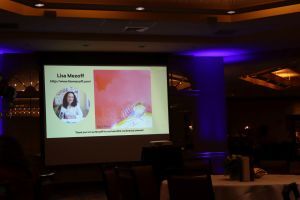
Between the time I registered in early March and the weekend it was held in late April, I sort of put it out of my mind thanks to other aspects of life. I’m here to tell you that while the World Health Organization may have declared COVID is no longer a major health issue, the aftereffects of stress and social isolation, particularly those of a psychological nature, still linger. I hadn’t traveled out of Maine save for our week in the western national parks, since 2019, so driving to Springfield was a bit stressful. So too, was finding the hotel I was staying at which was different from the one where the conference was being held. Of course, I left everything I’d printed out lying on my computer desk in Waterville, but still managed to find both.
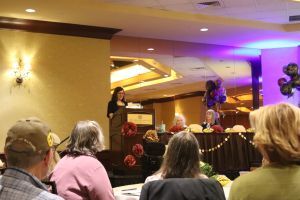
The conference itself was quite something. I’ve been to numerous national library and software conferences, as well as the New England Crime Bake and the Maine Crime Wave. Each has a distinct personality. This one did as well. On Friday afternoon, following registration, I looked at the giveaway table, and the book store before moving to the ballroom for opening remarks.
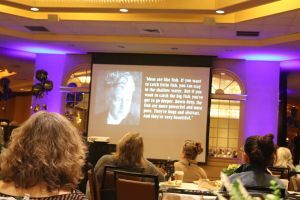
The New England chapter was founded by Jane Yolen in part because it was expensive and time consuming for her (and other authors) to fly to California every year. It has flourished. There was a sense of eagerness and joy among those sitting there on Friday night, more so in people who had been coming for many years. One statistic that jumped out (and sadly, I neglected to write it down) was how many books members of the New England chapter had published since the last conference. The number 135 comes to mind, but it could have been much higher.
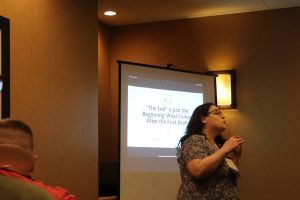
Meeting people is always a pleasant activity at conferences. I chose to sit at empty tables to see who joined me. The first people I met were a mother and daughter, the mom from Indiana, the daughter from Massachusetts who were working on turning the daughter’s grandfathers stories into a book. We were joined by three other people, all from Maine who were writing children’s picture books.
I was struck by the overwhelming support and encouragement offered by established authors to those who were very new to the process. I was also struck by what, for lack of a better description, was the vast range of opinions on how/when a book is ready to be published. I went to one workshop on the subject that made the process sound like creating a Star Wars movie.
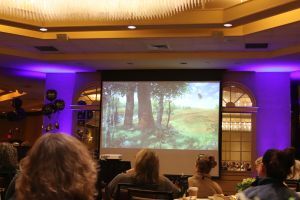
Like any conference, there were some workshops that I couldn’t relate to and others that had me listening to every word. I was impressed by Alexandra Hinrichs (Library Media Specialist from Old Town) and Julie Bilven (senior editor at Charlesbridge) who talked about the process of an editor and author working together. Alexandra also impressed me with her opening speech where she talked about the efforts in Maine to ban books at a time when some students are living in cars because of their families’ economic situations.
Among other workshops that impressed me were Sam Taylor’s Track to Overcome: Persevering through Personal and Professional Setbacks. I bought the book she was talking about immediately afterward and am passing it on to the Waterville Public Library. Then there was a great YA panel at the end of Sunday called Writing Authentic YA Characters When You’re No Longer a “Young” Adult. It was funny and very insightful.
Oddly enough, the most valuable insight came from a casual conversation with author Jo Knowles when she asked me what were my character’s motivations. I’ve been processing that question for the week since returning home. It was such a simple thing to ponder on the surface, but the more I’ve thought about it, the more I’ve started to play with that question in the scene I’m writing next in Thor’s Wingman. How does a teen protagonist figure that out when they’re already in a situation where they have no choice but to keep going. Stay tuned for the answer.
Here’s a link to all the workshops offered at the conference. https://newengland.scbwi.org/files/2023/01/Workshop_Descriptions_23.pdf
May 8, 2023
Writing Success, Gratitude & Process

Success: it means something different to everyone. As writers, we have concrete markers to measure traditional definitions of success: sales, reviews, awards, money and publishing status. But is that how we really view ourselves as authors?
We authors view ourselves differently then readers and non-writers see us. Despite my own insecurities and hang ups, I’m always startled when people are impressed that I’m a novelist, or shower praise on one of my books. Why don’t I view myself the way outsiders view me? Because success is a relative concept? Do New York Times bestselling authors feel like failures if they haven’t published a bestselling novel in years? Or if they haven’t won a Pulitzer or Nobel? An Edgar or Agatha?
I remember when I was unpublished and struggling with my manuscripts. I would have given my left arm to have a novel published. To me, just having that happen would have been the culmination of all my hopes and dreams. Then it happened and it was an amazing experience. It’s like your first kiss: you never forget it. So what happened in the ensuing years and the other ten books?
I’ve been traditionally published by a big NYC publisher. I’ve self-published and published under fantastic indie publishers. I’ve made good money and won some big awards. And yet I’m still hungry and unfulfilled. It’s a bit like making money. If you make one million dollars, you want two. If you earn ten million, you want twenty. And so on and so on. I think this is natural human behavior for someone who strives to achieve so much in life. It’s also a self-defeating and harmful way of thinking if taken to the extreme.
Are there second acts for us seasoned writers who have been at this for awhile? Am I delusional for feeling like every book I write has the potential to be a New York Times bestselling book? I don’t think so. As writers, we need to feel optimistic and empowered if we are to write the best novel we can. We need to feel like what we have penned is on par with Shakespeare and Dickens. We just need to keep bringing the positive vibes if we’re to keep getting published.
For me, what it comes down to is gratitude. We need to constantly remind ourselves how far we’ve come and what we’ve accomplished, whether we’ve written ten novels or one short story. Any writing is a great accomplishment, and we need to be thankful for bringing forth art. Get yourself off social media and stop looking at what other people are posting and doing. While I’m happy for the great success of my fellow authors, one cannot compare themself to others.
And this is where process comes in. What I’m most grateful for is my love of the writing process. The act of turning inward and burying myself in the most beautiful and mystical of life’s activities: creation. I believe it’s spiritual in a lot of ways. This is what I’m most thankful for as a writer. Despite my frustrations and constant bitching and moaning about my status as a writer, I still love writing. When I’m writing, I don’t care about all that. I’m in the moment and feeling the juice of life’s most wonderful gift. Honestly, I feel like a god.
Be grateful for your success, whatever level you’ve attained. And when the idea of success starts to make you queasy, lose yourself in the writing process and let it carry you away. Writing catapults us into the moment, where we (through our characters) experience love, death and every emotion in between. For most writers, this is where it all started.

May 5, 2023
Weekend Update: May 6-7, 2023
 Next week at Maine Crime Writers there will be posts by Joe Souza (Monday), John Clark (Tuesday), Vaughn Hardacker (Thursday), and Maggie Robinson (Friday).
Next week at Maine Crime Writers there will be posts by Joe Souza (Monday), John Clark (Tuesday), Vaughn Hardacker (Thursday), and Maggie Robinson (Friday).
In the news department, here’s what’s happening with some of us who blog regularly at Maine Crime Writers:
Coming soon (June 9-10): Maine Crime Wave! Lots of Maine Crime Writers will be there. Registration is now open. For more information, click here:
https://www.mainewriters.org/maine-crime-wave
Matt Cost will be celebrating the launch of his twelfth book, Velma Gone Awry, at the Brunswick Golf Club from 3-5 p.m. on Saturday, May 6th. Come hoist a drink and consecrate the birth of this historical PI mystery with me. On May 12th, Cost will be at the Centerville Public Library doing a Mystery Making panel with fellow authors Connie Hambley, Kat Fast, and Arlene Kay from 1-2:30 pm.
An invitation to readers of this blog: Do you have news relating to Maine, Crime, or Writing? We’d love to hear from you. Just comment below to share.
And a reminder: If your library, school, or organization is looking for a speaker, we are often available to talk about the writing process, research, where we get our ideas, and other mysteries of the business, along with the very popular “Making a Mystery” with audience participation, and “Casting Call: How We Staff Our Mysteries.” We also do programs on Zoom. Contact Kate Flora
MAYBE TOMORROW
post by Jule Selbo
I thought I was going to finish the latest book in my Dee Rommel series (8 DAYS, A Dee Rommel Mystery) last week. Last Friday.
Didn’t happen.
Saturday it didn’t happen.
Or Sunday April 30. I thought for sure I’d write “the end” by the last days of April.
Didn’t happen.
Now it’s Thursday, May 4. And I am still tweaking pages 163-180. I have one (maybe two) chapters to go – including parts of the hellzapopping climax. Story elements are outlined, scenes have been rolling around in my head for weeks, but something (what the heck is it?) is not letting me get there because I still have too many “FIX THIS” and “SHOULD THIS BE MOVED?” notes to myself on pages 163 to 180.
Some writer friends notice my sloping shoulders and less than cheery countenance and advise: Just write. Get it out. Move forward to the end, then you can address those “FIX THIS-es”. They advise me to avoid paralysis.
I’m not paralyzed. From 5 am to noon, I’m actually having a good time going over and over and over and over pages 163 -180. With each pass, I feel the characters deepening, the themes I’m playing around with strengthening. I notice the need to tighten the noose more, to ratchet the tension more and it’s fun trying to do that. The morning writing hours are okay. But then it gets to be noon and I see I haven’t moved onto page 181 and I feel that “you are useless” self-analysis settle in.
I really do want to move on. Sometimes I look for inspiration that will allow me to do so. I’ll look up (on Brainy Quote or somewhere) some old adage that will do two things: #1 – Remind me I’m not the first person who has ever struggled with the “get to the end” problem and #2 – Rewrite the quote, epitaph, proverb, axiom or poem so it is absolutely speaking just to me.
Like:
“Winners never quit and quitters never win.”
I’ll rewrite it:
“Writers never let words make them quitters,
and the inability to find words will never win.”
(Makes no sense, but it works for me in a pinch.)
Or Churchill’s:
“Never give up on something that you can’t go a day without thinking about.”
I’ll rewrite it:
“Never give up on writing a book that you know will work,
just because you’re tired of thinking about it.”
Today I decided to rewrite the late, great Leonard Cohen. He wrote:
I’m slowing down the tune,
I’ve never liked it fast.
Well, Leonard, I think to myself. Personally, I do like to do things quickly. We are at odds there. He also wrote:
You wanna get there soon
I wanna get there last.
Leonard, I get what you saying and it surely worked for you, but we would’ve been a mismatched pair. I like getting there “sooner”, rather than later. Patience is not one of my strongest virtues.
So, of course, I had to rewrite Cohen (shame on me):
I’m lacing up my shoes
‘Cause I do want to run
I’ll get there when I do
I’ve heard the starting gun
It’s not because I’m weak
And it’s not what lack of trying does
I’ve never liked it slow
Slow’s not in my blood
One of my good friends is a tarot card reader – she goes around the world practicing/doing her skill, hanging with other well-thought-of-readers, and is now working on her “medium” talents. It sounds a bit illusive and a lot of people don’t “believe” in channeling – but I’ve known her for years (could it be twenty years?). We met long before she explored her talents in cartomancy. She was a successful real estate developer in LA, she was a successful actor in television and movies, she started a clothing business, she raised a child, she acted on Broadway and off-Broadway in NYC and she was in a group of writers that all became my close friends. Totally grounded lady and loves to cook. But, looking back, I realized it wasn’t until she started studying the art of tarot card reading and then went to Belize to study with “a master” that she really became “happy” and pleased and committed to doing one main thing in her life. Anyway, every month or so we get together on Zoom and she reads my cards, and just the other day, I told her of my angst. She laughed, said all her clients are whining and frustrated right now – something about some planets being in retrograde and some dissolution of old patterns and constructs in the universe that are making people particularly snarky and/or unhappy.
I asked “the question” that I wanted her and the cards to focus in on – about feeling “stuck” in one section of the book and so desperately wanting to move on. She concentrated on the question and chose (at random) tarot cards from the huge deck. She studied them, did notice that the “worry” card (something with six coins) dominated, but was surrounded by “heart” cards. Basically, as she interpreted the cards, the message was to stop worrying about the structure, that the base of this particular case for my main character (Dee Rommel) lay in the heart. That Dee’s diligence and work ethic and desire to solve things fast – (and me, as writer, trying to follow that path) – was sure to stall because I wanted structure to carry me through. That I needed to go back to why this case touches Dee – and be willing to let her fail in order to grow as a person.
Okay. Everything my friend had read in the cards had been roiling in a back back back portion of my brain. And I had been pushing against it. Sometimes, being agreed with by a deck of over-sized cards with weird pictures on them (even if it was an idea that you tried to bury) can release an energy. Anyway – I felt better.
And I moved on to page 181, telling myself I didn’t have to follow the outline/denouement I had set up.
Just to conclude, I’ll share my rewrite of a poem by novelist, poet, hymn writer Henry Van Dyke.
Time is too slow for those who wait,
too swift for those who fear,
too long for those who grieve,
too short for those who rejoice,
but for those who WRITE, time is eternity.
I suppose you can spot my rewrite.
May 3, 2023
Maine Crime Wave 2023 – A Preview
If you haven’t done so already, mark your calendar for June 9 and 10, when the Maine Crime Wave will roll into Portland, carrying crime writers and fans of crime fiction in its wake. This year’s ‘Wave, to be held at Glickman Library at the University of Southern Maine, has a packed schedule of fine writers who’ll be talking about their process and motivation, and on Friday evening, reading recent work.
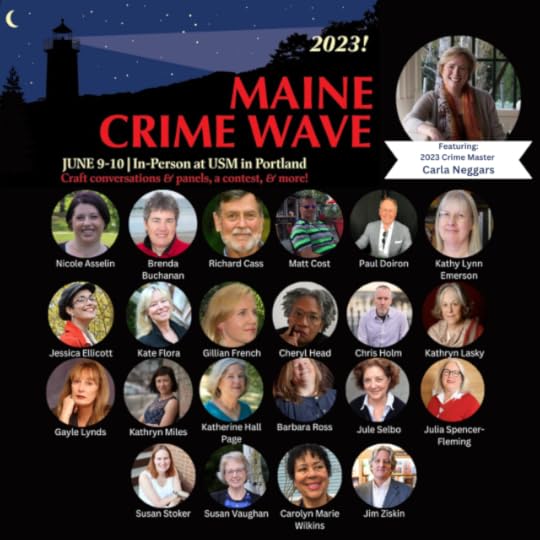
Carla Neggers is the 2023 Crime Master. A New York Times and USA Today bestselling author whose books feature both suspense and romance, Carla has published more than 75 books and been an active member of both International Thriller Writers and Romance Writers of America. For more information about Carla and her books, go here: https://carlaneggers.com/
Carla will share wisdom and stories in an interview with award-winning, top-notch crime writer Julia Spencer-Fleming on Friday evening starting at 5:45 p.m., after a bit of schmoozing that begins at 5 p.m.
At 7 p.m. the ever-popular Two Minutes in the Slammer will commence. About a dozen writers will take the stage for two-minute readings that, if past is prologue, will be gripping, suspenseful or hilarious (and some will almost certainly tick all of those boxes). Rob Kelley, resting on his laurels after winning this event several years in a row, will serve as MC.
Saturday’s program kicks off at 8:30 with coffee and chat, followed by the first panel of the day at 9:00, History’s Echoes: Crime Fiction and Nonfiction Rooted in Real Life. The panelists are Cheryl Head, whose much-celebrated new novel Time’s Undoing is inspired by her own grandfather’s murder in the Jim Crow south, James Ziskin, whose latest mystery, set in India in 1975, draws on the real life political turmoil of the time, Carolyn Wilkins, whose historical novels with paranormal elements are set in the 1920s (and who herself is a psychic medium) and Kathryn Miles, a journalist whose current book—nominated for an Edgar Award this year—digs into the story of two women with Maine ties who were murdered while hiking the Appalachian Trail in the 1990s. Jessica Ellicott, writer of multiple popular historical and cozy mysteries series, will moderate.
At 10 :30 the topic shifts to Plotting Across Genre. Panelists Gillian French, author of acclaimed thrillers for young adults, Gayle Lynds, who wears the crown of the Queen of Espionage Fiction for her propulsive spy novels, Chris Holm, whose action packed novels—including last year’s Child Zero—draw on his background as a molecular biologist (in the most thrilling possible way) and the aforementioned Julia Spencer-Fleming, whose best-selling mysteries feature an Episcopal priest who teams up with the local police chief to solve murders in the Adirondacks. This one will be moderated by my blogmate Jule Selbo, who is highly skilled at stoking a good conversation.
At lunchtime, a special award is going to be presented and that’s all I’m going to say about it.
After the mid-day break, we’ll get down to it with a panel discussion of Love and Death: Writing Romantic Suspense. Four experts on this topic will share their thoughts: Crime Master Carla Neggers, MCW blog alum Susan Vaughan, author of 16 novels of powerful romantic suspense, Susan Stoker, a prolific and bestselling author (NYT, Amazon, Wall Street Journal) whose books feature, in her words, “Alpha men and strong women” and Paul Doiron, whose Mike Bowditch thrillers feature a long running sub-plot about the game warden’s love life (Stacey? Dani? I vote for the former). Moderating what will surely be a highlight of the conference will be the always-insightful Matt Cost.
At 2:45, a panel called Why That Series? will feature Nicole Asselin (her Red Sox series is a must-read for even the casual fan), Kathryn Lasky, well known for her series of children’s and young adult novels who’s recently published an acclaimed adult novel, Katherine Hall Page (last year’s Crime Master, whose Body in the . . . series is absolutely addictive, and MCW’s own Richard Cass, author of the wonderful Elder Darrow Series. Kathryn and Dick are both nominated for a Maine Literary Award this year for their most recent books Light on Bone, A Georgia O’Keefe Mystery (Kathryn) and The Last Altruist (Dick). Moderating will be Barbara Ross, whose newest in the fabulous Maine Clambake Series, Hidden Beneath, will be released on June 27 (get your pre-order in).
As if all that wasn’t enough, yours truly will moderate the final panel of the day, called What I Hate About Writing. An all-star gang of writers, some of whom will have participated in panels during the day, including Carla Neggers and MCW blog stalwart Kathy Lynn Emerson, will discuss the many travails of being an author, and if they run out of reasons to eschew the craft, I might let them talk about what they love about it.
Throughout the day the marvelous Barbara Kelly of Kelly’s Books-To-Go will be selling books, and authors will be hanging out at the book table to sign and chat.
Everyone is welcome—readers and writers (published and unpublished—and the registration link is here: https://www.mainewriters.org/calendar/crime-wave-registration-early-bird-2023-dzx6z
May 2, 2023
Doing the “Buy My Book” Dance
Kate Flora: I’m just a few weeks away from publication of my 26th book, Teach Her a Lesson, and my to-do list is long. Many of the things on the list are things I should have done six months ago, at least according to the checklists that describe the steps a writer should take leading up to publication. Truth? The very thought of it makes me exhausted.
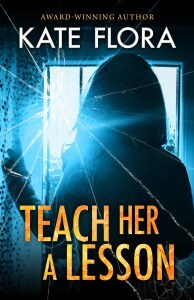 I do believe that if I’m going to spend months or years (in this case, twelve years) working on a book, the story, and my publisher deserve my best efforts. But those efforts take time and money and I’ve done them so many times before. As I look around my very small, crowded office, the efforts of past book promotions are everywhere. Posters, galleys, newsletters, freebies, author photos, postcards—I’m surrounded by the memories, and memorabilia, of previous book launches.
I do believe that if I’m going to spend months or years (in this case, twelve years) working on a book, the story, and my publisher deserve my best efforts. But those efforts take time and money and I’ve done them so many times before. As I look around my very small, crowded office, the efforts of past book promotions are everywhere. Posters, galleys, newsletters, freebies, author photos, postcards—I’m surrounded by the memories, and memorabilia, of previous book launches.
There’s the giant red paper clip and the cardboard gun that when you snap it through the air puts out a small paper that says “Bang.” There are postcards. There’s the very cool reusable red tote bag that folds up and fits in a tiny pouch.

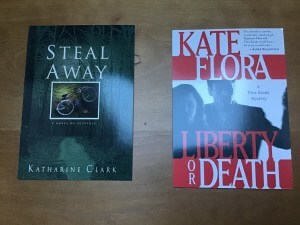
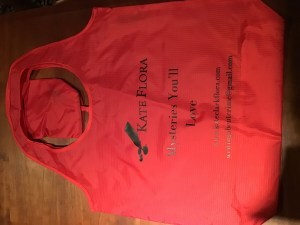
The sight makes me wish for a Fairy Godmother to flutter down beside me and offer her help. Like Cinderella’s carriage, I could wish that a magic wand could turn my ideas into reality. A swish of the wand and the mailing list has been created. Another swish and a newsletter, that newsletter my readers have been asking for, is written, formatted, and ready to fly. Swish #3 and a bookmark with books on both sides is neatly printed and sitting on my dining room table. As Joe Burgess often remarks, though, wishing rarely makes it so.
For other books, I’ve done flyers listing all of my books, and included a recipe so people will actually take it home and might even read it. I have done newsletters in the past and they also always included one of Thea’s “Quick and Dirty” recipes.
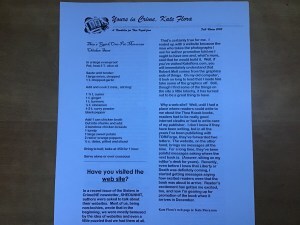
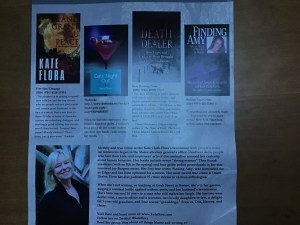
I know. You readers out there a sighing and muttering dark things about a pity party and via mental telepathy telling me to pull up my big girl pants and get on with doing what needs to be done. But what is that? And how much needs to be done? Again, referring to the advice to writers who hate marketing, I am supposed to figure out what I’m comfortable doing, and do that. Of course, what I like to do is write, and obviously I’ve already done that. I like to teach, but that doesn’t do much for book promotion. I love speaking at libraries and to book groups, but that requires me to craft a clever pitch and send out a zillion emails hoping some of the recipients will take the bait.
Of course, I will be doing things to promote the book. I’m so grateful that Encircle Publications liked it. I’ve asked my brilliant and clever friends for quotes for the cover, and the quotes are great. I’ve pulled together my meager graphics skills and created rack cards with the latest Thea Kozak mystery, Death Sends a Message, on one side and Teach Her a Lesson on the other. I’ve had a lovely student in New York City create a short, powerful book trailer. I’ve started on the mailing list for a newsletter.
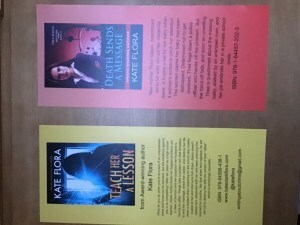
But if you, out there in reader land, know of a library or book group that would love a talk on how writing fiction and writing true crime make both genres better, or how I keep my series characters fresh after thirty years, or what it’s like to research true crime, or anything else about the writing craft, I am right here…and easy to find. Or if you know someone with marketing skills that an underpaid writer could afford? Or a journalist who might be interested in how a writer sustains a 30+ year career? Send them my way. That’s almost as good as a Fairy Godmother.
And if this works, here’s the book trailer: https://drive.google.com/drive/folders/1a0uTlJ3KSy0_7dpOyD4YnWdqlAjQKdVX
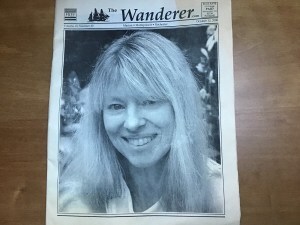
The writer in earlier days
April 30, 2023
Ghosts of Malice Past
Kaitlyn Dunnett/Kathy Lynn Emerson here. Malice Domestic, a gathering of mystery readers and writers, has just wrapped up its thirty-fifth conference in Bethesda, Maryland.
Although I would encourage anyone who writes mysteries, especially in the traditional and cozy genres, to attend, I was not there this year, nor have I been since 2019.
The two reasons most writers give for attending a fan convention are that it provides an opportunity for self-promotion (panels; signings; a fan lounge with tables for promotional materials; a bookroom with several bookstores represented; a bio in the program book) and an opportunity to meet, face-to-face, not only with readers and other writers, but also, in many cases, with editors and agents. Those were my reasons for starting to attend Malice Domestic, although I have to admit that socializing with writer and reader friends was the biggest draw.
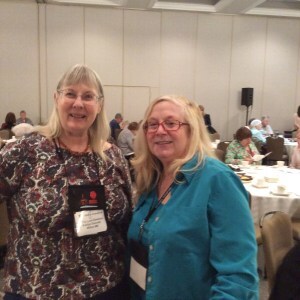
Kathy and Lea Wait at Malice Domestic 28
Sadly, far too many of those friends are gone now. Some have died. Others, like me, have physical challenges that make it difficult to be comfortable traveling far from home, especially if that travel involves negotiating airports and large hotels. I was sad not to be able to attend this year’s Malice, and to make up for not going, I took myself on a nostalgia trip to the twenty-five past Malice Domestics I did attend. Some of the best memories of my career as a writer took place at those gatherings.
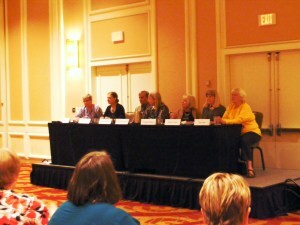
“You’ve Got Mail” panel in 2014
My first Malice was the third, back in 1991 at the Hyatt Regency in Bethesda. Among other highlights, I met with my editor, Carolyn Marino, and pitched what became a three-book deal with Harper Monogram. I made new friends and strengthened friendships formed at other, earlier conferences. I met Martha Detamore and the good folks of the Arsenic and Oolong Society, who for several years hosted a pizza party for those who didn’t want to attend the awards banquet. They also had cold pizza on hand the next day for snacking in their suite. But the memory that sticks with me most is the takeover of the stage during the banquet by Joan Hess, Dorothy Cannell, and Sharyn McCrumb to present a new award, the Whimsey. The Agatha is a teapot. The Whimsey was a stuffed groundhog in a dress. It was presented to Sarah Caudwell, who somehow managed to get it through customs and back to England. As far as I know, it is still there.
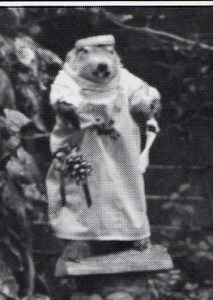
Such hi-jinks continued for many years, culminating in a final tribute to Barbara Mertz/Elizabeth Peters/Barbara Michaels that featured Sharan Newman, Parnell Hall, Dan Stashower, Joan Hess, and Dorothy Cannell in leading roles and used the curtains from Margaret Maron’s hotel room to make one of the costumes. The skits, often a roast of the Guest of Honor, ended after Barbara’s death. It was the following year, 2014, that I was Guest of Honor and Joan, Dorothy, and Margaret were joint Lifetime Achievement honorees. I didn’t get a skit, but I came close. During my banquet speech, I was heckled by the irrepressible Joan Hess. That was definitely a Malice highlight!
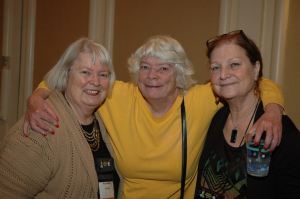
Margaret Maron, Joan Hess, and Dorothy Cannell 2014
At Malice Domestic in 1998, thanks to Anne Murphy, head of volunteers and a friend since Malice 3, I ended up getting my name and a quote in a USA Today article. That was a highlight, too.
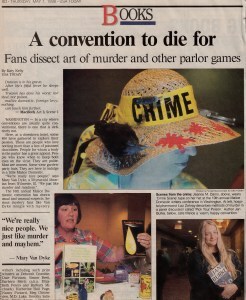
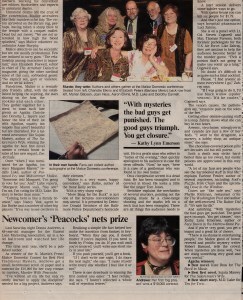
The years around that were also the formative ones for the American Crime Writers’ League, founded by Barbara Mertz. One memorable meeting was held in the hotel room shared by Joan Hess and Sharan Newman.
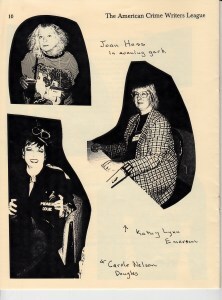
ACWL meeting attendees 1997
For several years, when I was writing historical mysteries, I became “the Face Down lady” at Malice. Fan girl moments had their place, too. Where else would I have met Anne Perry in an elevator and compared notes on the weather in Maine vs. the weather in Scotland in that particular April? And the British contingent were regulars in the past, especially Edward Marston and Robert Barnard. Then there was the year Malice shared a hotel with Lewis Farrakhan and his many bodyguards. That was certainly . . . different.
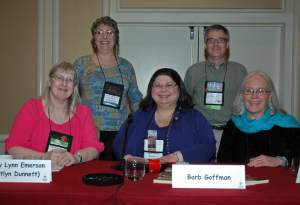
short story finalists panel Malice 2015
I won the Agatha Award for best mystery nonfiction in 2008 (presented in 2009) and was nominated for the best mystery short story Agatha Award in 2015. For those years and all the others, attending Malice was like coming home. At the best of the hotels used for the conference, the Hyatt Regency, there was a great lobby bar where it was easy to connect with friends both old and new. Unfortunately, the hotel was sold and the new owners took out the lobby bar. The current hotel, elsewhere in Bethesda, is nice but not nearly as cozy.

In many years, I traveled to Malice a day early and stayed until the day after, partly to avoid crowded travel but mostly for extra opportunities to visit with friends. Those of us not flying home until Monday morning would usually get together for dinner on Sunday night, a lovely, relaxed finale to a packed weekend.

I would still know some people if I had gone to Malice 35, but out of several hundred attendees, more or less evenly divided in number between authors and non-authors, there were only about a dozen people I would have expected to spend time with. I always looked forward to hanging out with Dina Wilner, Anne Murphy, and Chris Cowan, and I know I’d have caught up with Steve Steinbock, Vicki Thompson, and Marcia Talley, as well as with most of the team responsible for organizing Malice and some of the New England contingent. In past years, though, there would have been three or four times that many people I’d have made it a point to look for, and dozens of others who would have rated a hug and a hello. The last few years I attended, I traveled from Maine with Lea Wait and we roomed together for the last two.

It’s natural that things change. And natural to move on. I hope Malice Domestic will thrive for many more decades. I’m just sad that so many of the people who made it special during the years I attended are no longer there, myself included. So today I am missing and thinking fond thoughts of those friends who are gone, especially Lea, Margaret and Joe Maron, Carole Nelson Douglas, Joan Hess, Parnell Hall, Sheila Connolly, Sally Fellows, Doris Ann Norris, Joyce Christmas, Sue Feder (who would come to Malice dressed as Brother Cadfael), and Martha Detamore, and those who are still with us, but who, like me, no longer make the annual trek to Bethesda: Sharan Newman in Ireland, Eve Sandstrom/JoAnna Carl and Carolyn G. Hart in Oklahoma, Dorothy and Julian Cannell here in Maine, Charlaine Harris in Texas, and Miranda (Dean) James in Mississippi.
As Bob Hope used to sing, “thanks for the memories.”
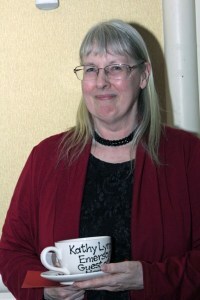
Kathy Lynn Emerson/Kaitlyn Dunnett has had sixty-four books traditionally published and has self published others, including several children’s books. She won the Agatha Award and was an Anthony and Macavity finalist for best mystery nonfiction of 2008 for How to Write Killer Historical Mysteries and was an Agatha Award finalist in 2015 in the best mystery short story category. She was the Malice Domestic Guest of Honor in 2014. Her most recent publications are The Valentine Veilleux Mysteries (a collection of three short stories and a novella, written as Kaitlyn) and I Kill People for a Living: A Collection of Essays by a Writer of Cozy Mysteries (written as Kathy). She maintains websites at www.KaitlynDunnett.com and www.KathyLynnEmerson.com.
April 28, 2023
Weekend Update: April 29-30, 2023
 Next week at Maine Crime Writers there will be posts by Kaitlyn Dunnett/Kathy Lynn Emerson (Monday), Kate Flora (Tuesday), Brenda Buchanan (Thursday), and Jule Selbo (Friday).
Next week at Maine Crime Writers there will be posts by Kaitlyn Dunnett/Kathy Lynn Emerson (Monday), Kate Flora (Tuesday), Brenda Buchanan (Thursday), and Jule Selbo (Friday).
In the news department, here’s what’s happening with some of us who blog regularly at Maine Crime Writers:
Coming soon (June 9-10): Maine Crime Wave! Lots of Maine Crime Writers will be there. Registration is now open. For more information, click here:
https://www.mainewriters.org/maine-crime-wave
Matt Cost had a presentation along with fellow author Anne Britting Oleson on Friday, April 28th, at the Newport Cultural Center in Newport.
On Saturday, April 29th, Matt Cost will be signing books at Sherman’s Maine Coast Bookshop from 11 a.m. too 1 p.m.
On Saturday, May 6th, Matt Cost will be celebrating the launch of Velma Gone Awry at the Brunswick Golf Course from 3-5 p.m. on River Road in Brunswick. Come have a beverage and a snack and beat the drum of completion with me!
An invitation to readers of this blog: Do you have news relating to Maine, Crime, or Writing? We’d love to hear from you. Just comment below to share.
And a reminder: If your library, school, or organization is looking for a speaker, we are often available to talk about the writing process, research, where we get our ideas, and other mysteries of the business, along with the very popular “Making a Mystery” with audience participation, and “Casting Call: How We Staff Our Mysteries.” We also do programs on Zoom. Contact Kate Flora
Cops and Killers by Kait Carson
Hi there, I’m the new kid on the block. Being invited to blog with the Maine Crime Writers is a dream come true. You have no idea how much this blog meant to me when I lived in the steamy Florida heat. It was a breath of fresh air in more ways than one. Now, I’m proud to be a member.

Florida writing space
Originally from New Jersey, I fell in love with Florida at the ripe age of five and vowed to return. I moved to the Miami area for college and never looked back. Professionally, I was a paralegal with an estates and trusts practice. Lots of story fodder there. Amazing what families get up to when the will is read and the gloves come off. For fun, I became an avid scuba diver and occasionally worked with law enforcement as a civilian volunteer. When I began to write seriously, I wrote what I knew. Law and diving.
It’s easy to write what you know. As a paralegal, I’d absorbed the finer points of interviewing and legal process. As a civilian volunteer, I’d been to crime scenes, knew how to protect and process them, understood the macabre but elegant ballet that takes place between investigators and medical personnel. All of that was familiar ground, and I had a cadre of resources ready to fill in the gaps of my knowledge. Albeit the information often came with a side dish of snark. There must be a class in that in law school and the police academy!
Real life and The Miami Herald provided topics for more books than I could ever write, but Maine called. My home is in the Crown of Maine on almost two hundred wooded acres. There’s a quality to the silence here that is tangible. Anything can happen, help is far away, long dark nights and isolation do something to the human psyche. The crime rate is extremely low in the County, but the imaginative crime rate is a far different statistic.
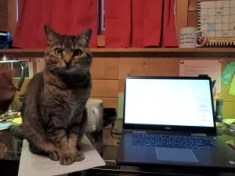
Maine writing space and office manager
In the depths of winter with the Northern Lights dancing on the horizon I began my first Maine novel. It’s set near a fictitious town in the Allagash. My main character has inherited her family’s long closed lodge and discovers a fresh kill body on the premises. This story, so easy to write had it been set in Florida, came to a screeching halt while I desperately researched Maine crime scene protocol in an area where everyone, from investigators to medical examiners, have to be imported. The logistics are astounding. The Maine State Police Public Information Officer has become my very best friend. All errors will be mine, and I confess to taking some liberties to serve the story.
The move from Florida to Maine felt comfortable and familiar. When it comes to crime writing, the move from Florida to Maine is like learning a new language. The goals of each law enforcement community are the same. The mechanics of achieving these goals are by necessity, varied. The differences are fascinating, and the list is long.
Kait Carson writes two series set in the steamy tropical heat of Florida. A new series is in the works, the Maine Lodge mysteries, paying homage to Kait’s current state of residence. Like her protagonists, Kait is an accomplished SCUBA diver, hiker, and critter lover. She lives with her husband, four rescue cats and a flock of conures in the Crown of Maine where long, dark, nights give birth to flights of fictional fantasies.
Lea Wait's Blog
- Lea Wait's profile
- 509 followers



